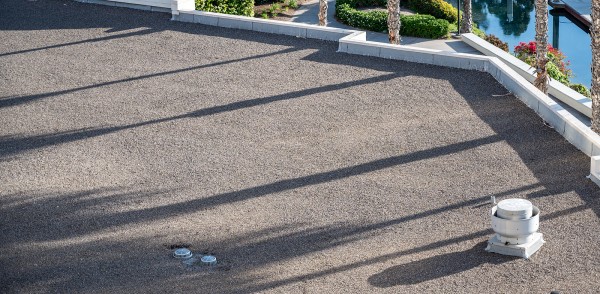You need a good roof over your head, and when it comes to flat roofs, the materials have to accommodate some challenges that are unique to the roof shape. You worry about heating, ponding water, and of course, cost.
Considering all of that, what is the best material for a flat roof?
Well, the answer depends on what you need out of your roofing material. There are different pros and cons for each material you can choose. So we’ll answer the question a little more specifically and show you the best option for each of the common applications listed below.
For Holding Weight
Flat roofs are common on larger, industrial buildings. As such, many industrial buildings try to take advantage of the large square footage at the top. You might find storage, solar panels, or even places where people frequently walk.
If your roof needs to be able to hold weight or endure foot traffic, then one material clearly stands above the rest: built-up roofing (BUR).
Built-up roofing is not a single material. Instead, it consists of multiple layers of different materials, each laid above the others. The very top layer is usually asphalt, gravel, or something comparable. As a result, built-up roofing is extremely strong and durable. It can handle the worst kinds of weather, and it’s made to last for multiple decades.
Most importantly, it can handle more weight than any of your other common flat roof materials.
For Ponding Water
One of the biggest issues that plagues flat roofing is ponding water. While most flat roofs are built with a small incline to help them drain, different features on the roof can trap water and lead to ponding. Once water is trapped on the roof, it adds weight to the structure, and it can slowly dissolve seals or otherwise compromise the roof.
When you have a roof with spots that are at a higher risk of ponding, this is the top concern, and for this, you want materials that don’t have seams. That’s the real key, and there are three materials that are great in this regard: PVC, TPO, and EPDM. TPO and EPDM are going to come up in later sections, so we’ll talk about PVC for now.
PVC is exactly what you think it is. It’s a type of plastic that is completely waterproof, and you can make entire roofing layers out of it.
For Cost-Effectiveness
When it comes to bang for your buck, the competition is stiff, but this metric is why EPDM is the most popular roofing choice of all right now (for flat roofs).
EPDM is a type of rubber roofing. It goes on very easily as a single-ply substance. You more or less brush it onto the roof substrate. It’s quite affordable as far as these kinds of roofing materials go, and it’s still made to last for 20 years or longer.
As a result, EPDM tends to offer the best protection and longevity when compared to the cost of installation.
For Temperature Control
When you pick the right roofing material, you can increase solar reflectivity. Essentially, this reduces the amount of solar energy that gets past the roof and into the building. Considering that Texas summers are much longer than winters, this is an important consideration. A good roof can substantially lower cooling bills, and for large commercial buildings, those savings can more than justify the cost of a roofing material once you account for the differences in reflectivity.
Among flat roofing options, there are two materials that stand above the rest: EPDM and TPO. We’ve already talked about EPDM, and the rubbery material doesn’t absorb excessive amounts of solar energy. As a result, it keeps buildings a few degrees cooler, on average, when compared to most flat roofing choices.
TPO is a similar material. It’s basically a newer, updated version of EPDM, and it was largely designed to replace EPDM. TPO offers many of the same advantages in terms of longevity, cost of installation, toughness, and ease of installation. But, because TPO is a little newer, it’s a little more expensive to install.
All of that said, TPO is white by default, and that makes it even better in terms of solar reflectivity than EPDM. As a result, TPO is the best option you’ll find for lowering cooling costs if you have a flat roof.
Specialized Roofing Materials With Alpine Sheet Metal Systems
Those are the most common roofing material choices, but depending on the design of your flat roof, some other options may be viable. As an example, if the flat roof has enough angle to it, you can use zinc, which is the longest-lasting roofing material in the business.
To keep a long story short, your best option is to have an expert look at your roof and make recommendations. The best option depends on the design of the roof and what you want out of your roofing material. Armed with that information, an expert can walk you through your options in detail and help you find the perfect choice.To have that conversation in Dallas/Fort Worth, simply contact Alpine Sheet Metal Systems today. We’ll be happy to hear from you, and we’ll get your roofing options squared away with ease.

